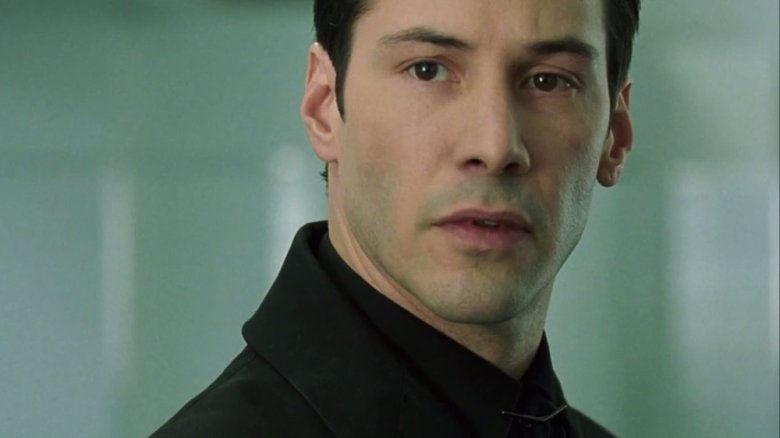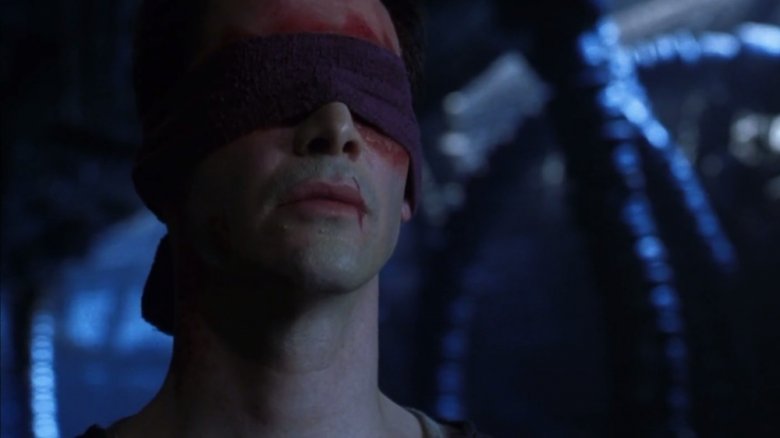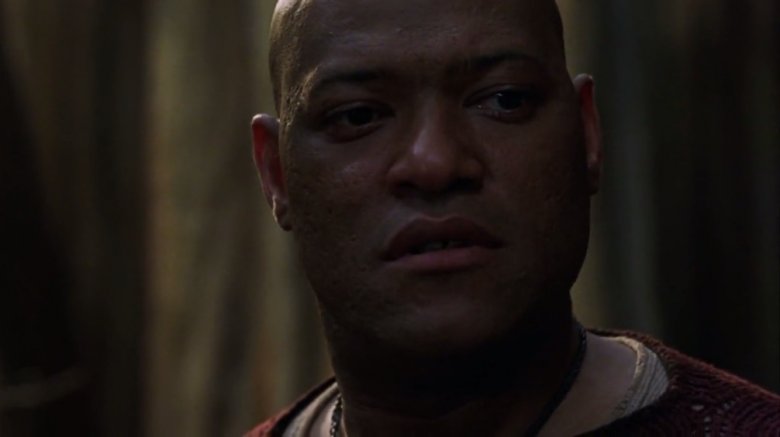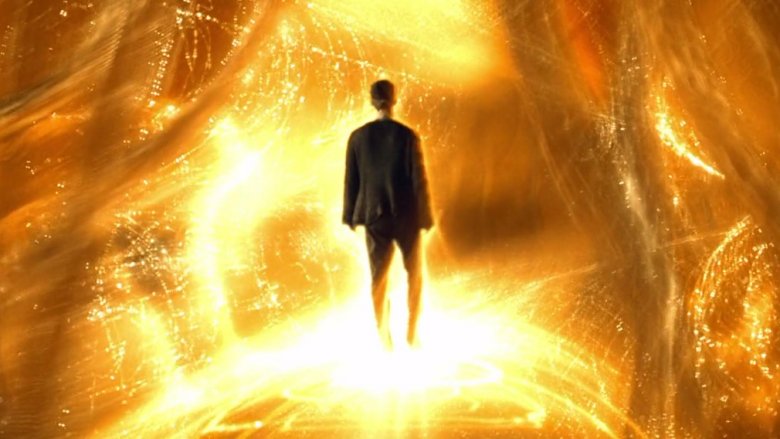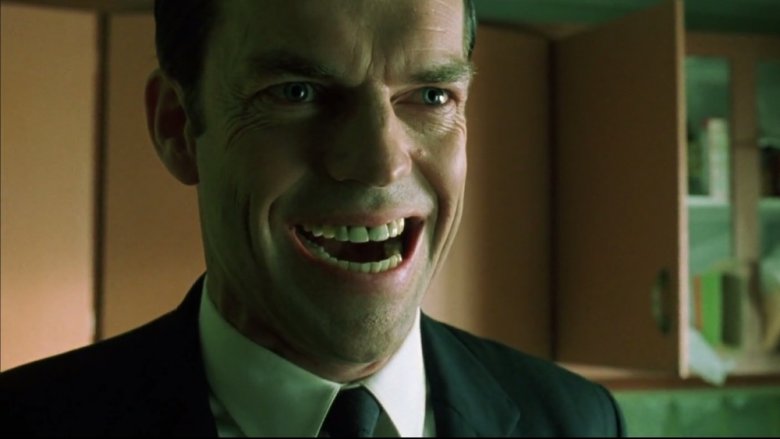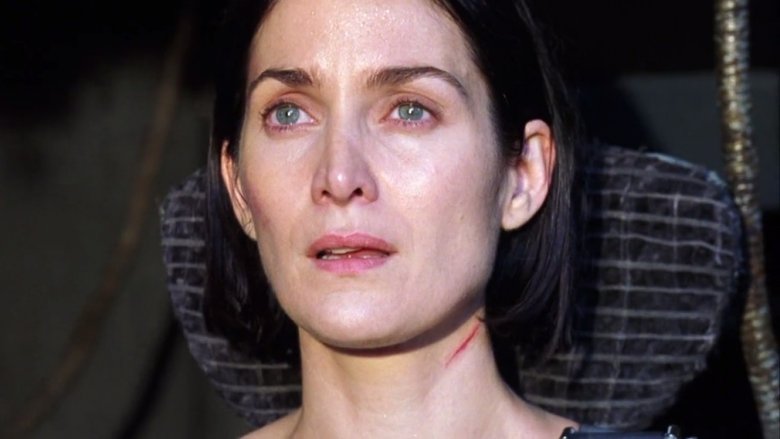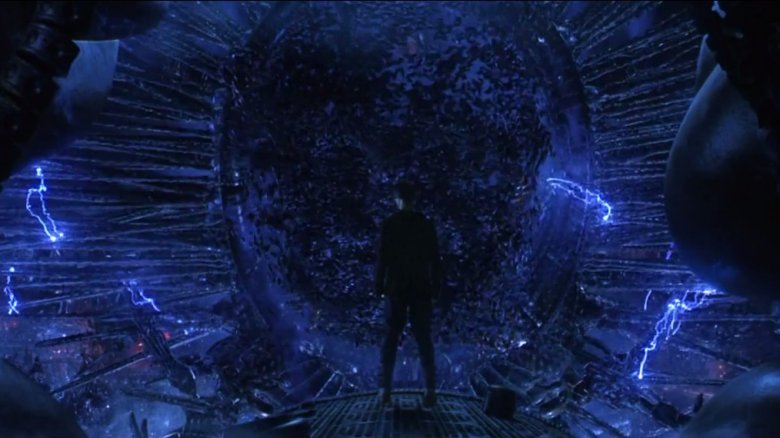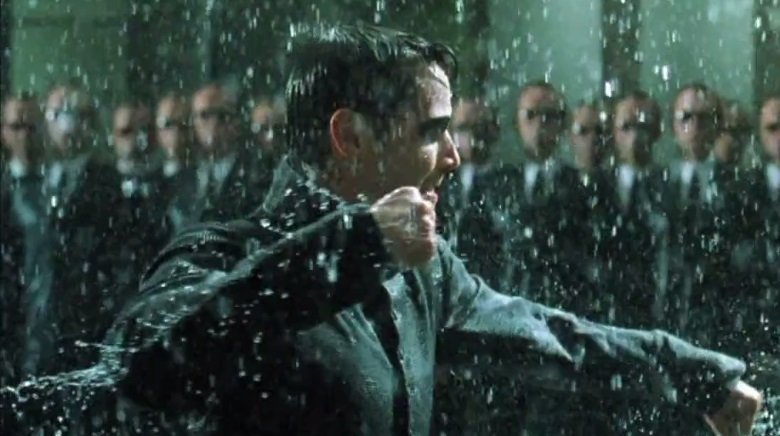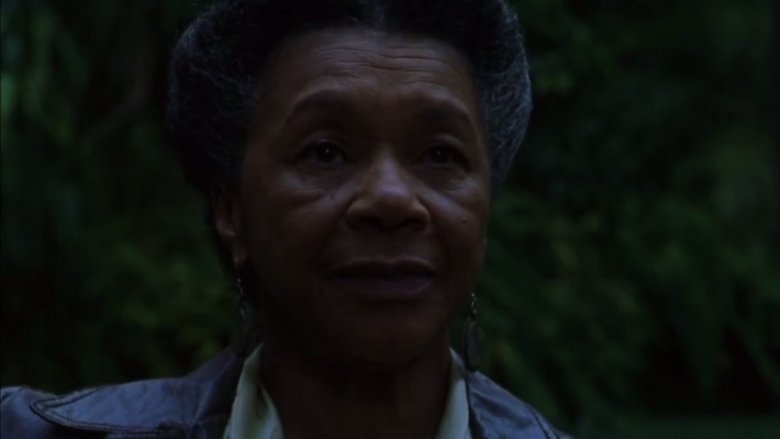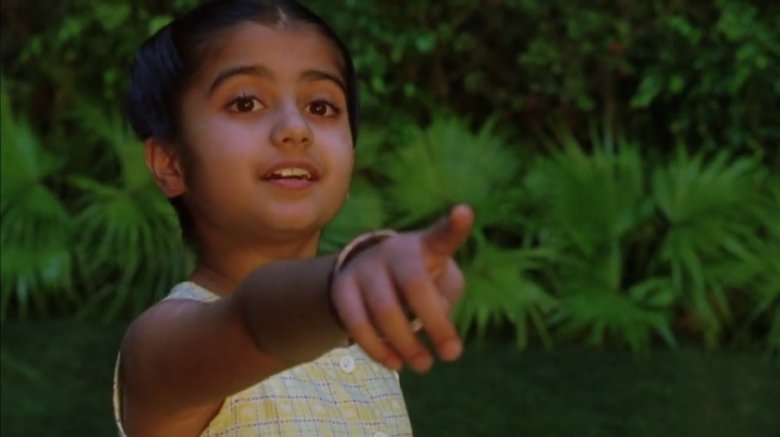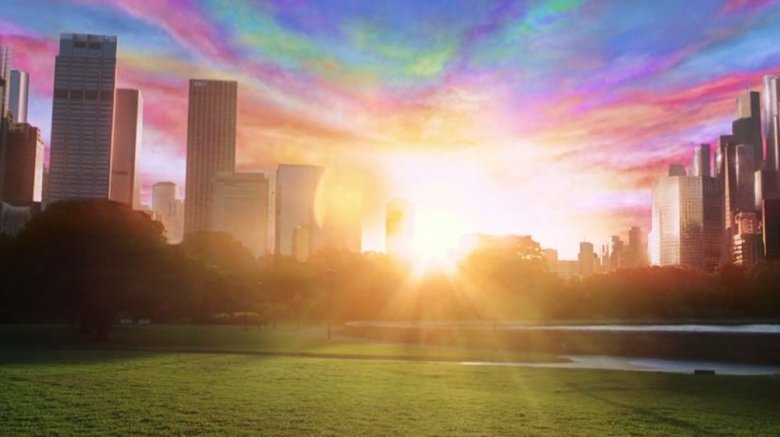The Ending Of The Matrix Trilogy Explained
When the sequels to The Matrix were released within months of one another in 2003, the world didn't quite know what to make of them. Rather than being straightforward follow-ups with more of the same wire-fu, bullet time, and techno music, the sequels were challenging and ambitious, building on what the original movie put down and thoroughly subverting viewer expectations.
It's too simple to say the sequels were too smart for audiences — there are plenty of dumb decisions that justify the third movie's low Rotten Tomatoes score. But if the sequels have flaws, it's not because they don't make sense. Instead, what makes the sequels so confusing is their occasional unwillingness to give things to you straight — something that's intentional by design. According to director Lana Wachowski, the sequels are an exercise in participation, putting audiences on the same path of discovery as Neo, whether they like it or not.
"The first movie is sort of classical in its approach," she said. "And the second movie is deconstructionist, and an assault on all of the things you thought to be true in the first movie. [...] The third movie is the most ambiguous, because it asks you to participate in the construction of meaning."
No wonder audiences weren't down with that. Now that we've got some years of distance between us and this massively influential series, let's construct the movies' meaning, and break down the conclusion of the Matrix movies. Here's the ending of the Matrix trilogy explained.
The man and the machine
One major theme that came to the fore as the series reached its conclusion had to do with the similarities between humans and machines. In the original, they couldn't seem more different, but by Revolutions, programs in the Matrix are portrayed as being almost more human than human — loving and happy individuals, as worthy of existence as any person. Further, characters from the first film who were firmly human or machine are portrayed in the sequels as having a little bit of both.
The similarities go in both directions. Neo, a human, reached the Source to discover that being the One was his destiny because it was programmed into him. Agent Smith, a program, copied his consciousness onto a human form, entering the real world through the vessel of resistance fighter Bane.
The humanizing of the Machines and the complimentary mechanization of Neo made for a storytelling turn that audiences weren't really ready for. People who saw The Matrix couldn't be faulted for expecting an ending that saw Neo winning by doing his Superman thing, fatally punching the machines to the kickass strains of Rob Zombie's "Dragula." Instead, Neo triumphed by becoming a bridge between man and machine, sacrificing his own life for the sake of securing peace. He also beat a guy to death with a pipe, but it was kind of secondary to the heady stuff, man.
Desert of the real
One widespread but inaccurate theory about the sequels is that the real world is actually a second Matrix. While the reasons why this isn't true are explained in the movies, they're also relatively easy to misunderstand.
The real world isn't another level of the Matrix — but it is involved in another system of control. As the Architect explains at the ending of The Matrix Reloaded, each version of the Matrix is propped up in the real world by a controlled rebellion. With each new iteration of the Matrix, a select portion of the population is freed, allowed to live in Zion. There, they help to liberate people still inside the Matrix, searching for the One.
Finding the One, the human rebels rally behind them, supporting them until they reach the Source. There, the One discovers that they are not meant to destroy the Matrix, but rather restart it. At this point in the cycle, the Machines attack Zion and destroy it, killing the rebellion.
The One, having reached the Source, is made to choose between either reloading the Matrix and selecting a handful of survivors to build a new Zion, or walking away, supposedly causing a system crash, leaving the humans inside and outside of the Matrix all dead.
Up until Neo, every One made the choice to restart, perpetuating the system of control. Because Neo loves Trinity, he chooses to sacrifice everything to be with her. This is the choice that makes him special.
I see you
Proponents of the second Matrix theory support it by pointing to the powers Neo is able to manifest in the sequels' real world, being able to see without eyes and exert control over approaching Sentinels.
For a lot of viewers, this breaking of the rules almost felt like a betrayal, with the audience having been made to believe that Neo could only manifest his "superpowers" in the Matrix. But Neo isn't able to destroy Sentinels because he's the One — it's because he reached the Source.
Prior to the arrival of the Sentinels at the ending of The Matrix Reloaded, Neo explained that he could "feel them" before he remotely destroyed them with his mind. That feeling isn't metaphorical — it's literally true. Neo, having reached the Source of the Matrix, has established a connection with everything else connected to the Source — like the Machines themselves. He has, essentially, joined their wireless network. Among other things, it's why he's able to move through the Trainman's purgatory world at the beginning of Revolutions without being jacked in.
After reaching the Source, he's connected to the Machines, able to see and sense them even after being blinded, seeing them in yellow via a sort of sixth sense. It's why he's able to navigate the Machine City, or see Smith inside of Bane during their fight — Smith is of the machines, connected to the Source just as Neo is. Thanks to that handy conduit, he doesn't need eyes to kick Smith's ass.
The virus
In the original Matrix, Agent Smith's character was his job description — an agent for the Matrix who aims to police the populace by stomping down any signs of rebellion. But his encounter with Neo as he learned he was the One left the program shaken, and he began to rebel himself. As a consequence, Smith becomes much scarier and more powerful as a rogue program than he ever was as an Agent.
In the second two movies of the trilogy, Neo and Smith become mirror images of each other, with Neo gaining a connection to the Matrix through the Source, and Smith gaining a connection to the real world through his override of Bane's brain. If Smith is the Matrix's virus, then Neo is his natural anti-virus, a connection which the Oracle makes clear during her final talk with Neo.
When Neo blew Smith apart at the ending of The Matrix, he made a massive imprint on the program. As a part of the Matrix's attempt to, as the Oracle explained it, "balance the equation," Smith gained new attributes, becoming a sort of virus in the Matrix, overriding everything in an effort to bat back Neo. The fact that his spread is destructive to the Matrix doesn't matter to Smith anymore. He's a rogue program now, cut loose from Machine control, with his only purpose being to propagate himself. He doesn't know why, and doesn't choose to do it. It is, quite simply, his purpose.
Above the clouds
After Neo meets the Oracle for the last time, he takes Niobe's ship and makes his way, along with Trinity, to the Machine City. It's a locale no human in memory has ever reached, and Neo and Trinity are only able to punch their way through by Neo's new connection to the Sentinels.
With an outstretched hand, he begins blowing the approaching Sentinel swarm to pieces, seeing them with his yellow vision, fighting them back with his mind through his connection to the Source.
His powers, while formidable, aren't godly. When the Sentinel swarm threatens to destroy the ship before it can reach the city, Neo advises an upward juke. Trinity pilots the ship up into the cloud cover, pierces the storm, and sees the bright sunlight above for the first time in her life.
Neo, blinded save for his Machine-vision, can't see a thing, so the majesty of the sight is all Trinity's. Neo, the metaphorical half-man, half-machine, has already seen the Source of Machine life; now Trinity is seeing the source of human life, and it's just as transformative.
The reason why the sky is blacked out in the first place was explained in a two-part short film, The Second Renaissance, released as part of The Animatrix. This canonical tale explained why the humans blocked out the sun during the Machine uprising, hoping to cut them off from a solar power source. Instead, they sort of just doomed the world. Oops.
Mecha
When Neo arrives at the Machine City, he's met by what is, essentially, the collective voice of the Machines. (Well, first he watches Trinity die for about 35 minutes — you remember that fun scene.) The interconnected hive mind adopts a human face to speak to the first human ever to set foot inside the city's walls.
Neo approaches the Machines with a deal — he knows that Smith is ravaging the Matrix, corrupting everything, taking control of the entire system. The rogue program is a mutual enemy of both species, and Neo offers to handle the problem in exchange for one thing: peace.
By this point in the story, the Machines' usual plan for the Matrix is in utter disarray. Neo, having made his choice not to reload the system upon arriving at the Source, is now in totally new territory. He's already broken the loop, but still needs to accomplish two goals: saving humanity from the machines, and saving the machines from Smith. If he fails, everyone dies — there will be only Smith. As the onetime Agent gone rogue would likely put it, "Mwa ha ha ha ha."
The stakes laid out, the Machines agree to Neo's offer, jacking him into the Matrix to take on Smith for the last time.
The anti-virus
When Neo enters the Matrix for his gigantic Super Saiyan battle, he doesn't do it with the goal of beating Smith to death. How could he? Smith is everywhere and everyone.
Neo and Smith battle as Smith's limitless ranks look on, but Neo doesn't best the program in the fight. Despite a hard-fought struggle, he doesn't even come close. Instead, Smith drives him into the ground, leaving him broken at the bottom of an enormous crater. There, with Neo cornered, the program all but begs Neo to share with him his reason for continuing to fight.
Neo reveals that he continues to fight because he chooses to, and Smith, for all his power, cannot comprehend the concept. He is not a creature of choice, but a creature of purpose. He copies himself mindlessly as a force of corruption, a symptom of the Matrix desperately trying to balance itself out.
It's the choice to fight, rather than the fight itself, that makes Neo win the battle. Neo doesn't succeed by coming out on top — he wins by taking the battle with Smith to the very end, and choosing to sacrifice himself by letting Smith copy over him. The anti-virus cancels out the virus. If Smith had a choice, he wouldn't have done it — but Smith doesn't have choice. He only has purpose, and he successfully fulfills his purpose — which is why, as he dies, all he can say is that the outcome is not fair.
The plan
The Matrix series ends not on a celebration in the real world, but on a moment of reflection among programs inside the seventh version of the Matrix.
With Smith destroyed, the revived Oracle sits and watches the sun rise as the Architect approaches. This is what it's always been about — this battle between two programs, a yin and a yang. The cold philosophy of the Architect and the faith of the Oracle have been driving the conflict since its beginning, and now they meet in a condition of cease fire.
The series doesn't really explain the nitty-gritty of it, but Neo's defeat of Smith is ultimately all the result of the Oracle's intervention. In the first movie, the Oracle basically serves as matchmaker between Neo and Trinity, telling them it is their destiny to fall in love. Is it really, though? Well, no — if the sequels make one thing clear, it's that nobody is really destined to do anything. It's all about choice.
The Oracle's encouragement of Neo and Trinity's romance provides the rogue element that lets Neo break out of the cycle of control when he reaches the Source. Instead of reloading the Matrix, he leaves to be with Trinity, damn the consequences. It was Neo's choice, sure — but it was also part of the Oracle's plan.
Did she know it would work? No — but she believed, and she was right. The element of love was the one thing the Machines couldn't prepare for.
The meaning of Sati
One of the most curious and underexplained characters in the Matrix sequels is the young girl Sati, who is treated with much importance without the why of it all really being explained.
The daughter of two programs Neo meets inside the Trainman's purgatory, Sati is a program without purpose, born as the result of love between two individuals. In the machine world, such an entity is a novelty, and also useless, subject to deletion, which is why Sati's parents are trying to shepherd her to shelter.
Thematically, Sati is the representation of love, a new concept to the Machines. Love, at the end of the series, is ultimately what secures the humans' victory. Neo's love for Trinity is what drives him to make the choice to reject reloading the Matrix, and instead fight for a better peace. The Machines' inability to comprehend love left them with that blind spot, allowing Neo to go against every logical choice to make his own choices instead.
Sati can be seen as the Machines' way of trying to make sense of love. At the end of the movie, she is essentially what the Machines have decided to let control the Matrix, with the Architect and Oracle's conflict being set aside for the system's seventh version. This, at least, is pretty much confirmed by the beautiful sunrise Sati says she made for Neo, and is supported by the new, compassionate approach to the Matrix's human population in the new version.
Version 7
The ending of The Matrix trilogy doesn't see the Matrix destroyed. In fact, it is renewed, rebooted for a seventh version, this time with new rules. As audiences learned via the (lengthy, heavy, circuitous) conversation with the Architect in The Matrix Reloaded, previous iterations of the Matrix all built on the flaws of the previous one, fine-tuning the system by which the Machines controlled humanity both inside and outside of the Matrix. With a peace secured and a new compassionate approach at hand, any human who desires to depart the Matrix will be allowed to leave. Certainly, some will stay — the Matrix is the ultimate virtual reality game, after all — but the conditions of enslavement are no more — at least for now.
The end of the movie implies that more cycles may be set to come; as the Oracle explained, the peace between the warring humans and Machines will only last "as long as it can." The peace is not guaranteed — the Architect makes that clear. Sati's mere existence is proof that the Machines are now working to understand this little thing called love, letting her steer the ship while they observe and learn. Maybe, at some point, forces within the Matrix will figure out how to use love against humanity, and enslave them again. Until then, it's a beautiful morning in the Matrix and beyond. The peace isn't guaranteed to last, but it certainly could — if humans and Machines choose to keep it.
